Yes, the chest press machine can absolutely help you build a bigger chest—when you use it the right way.
It provides a safe, stable way to overload your pectoral muscles without needing a spotter. The key is knowing how to set it up correctly, maintain proper form, and apply progressive overload to keep making gains.
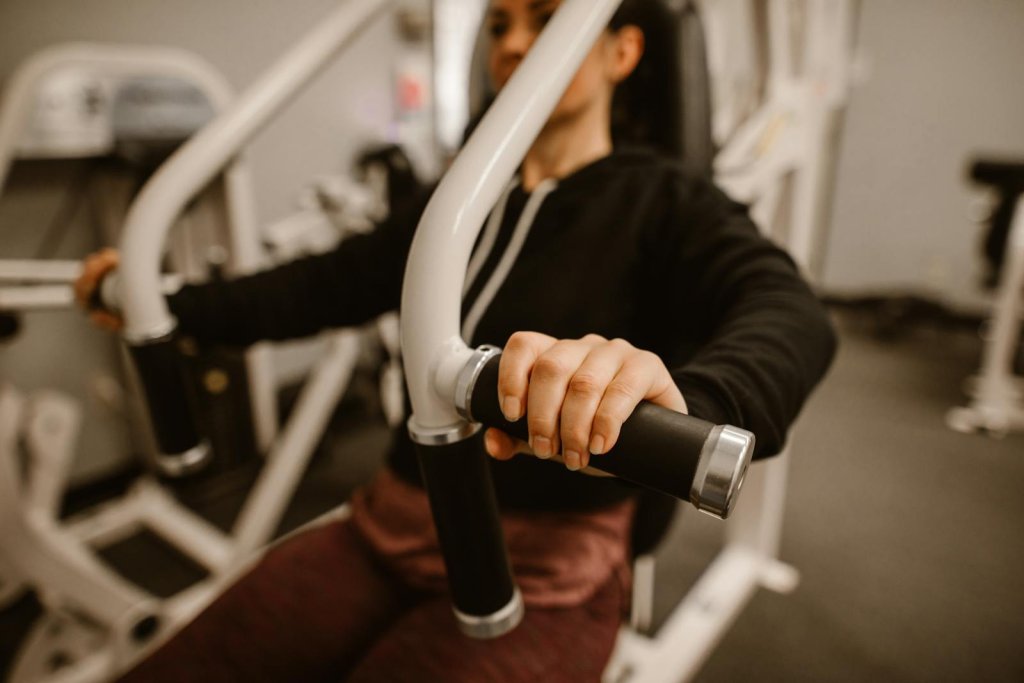
In this guide, you’ll discover five proven tips to maximize chest growth with the chest press machine, how to avoid common mistakes, and why combining it with other chest exercises is the smartest strategy for long-term results.
Benefits of Using a Chest Press Machine
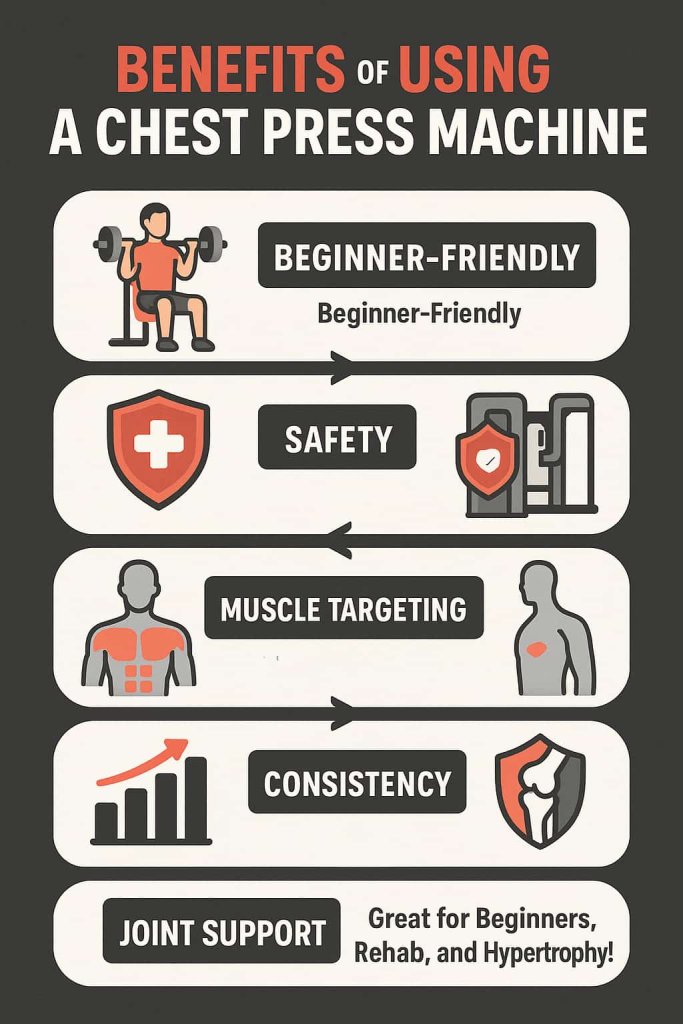
Before diving into the tips, let’s look at why the chest press machine deserves a spot in your workout routine:
- Beginner-friendly → Provides stability and guided motion, reducing risk of injury.
- Safety → No spotter required, unlike heavy free-weight bench presses.
- Muscle targeting → Isolates the pectorals while minimizing stabilizer fatigue.
- Consistency → Fixed path makes it easier to track progress and maintain proper form.
- Joint support → Ideal for lifters with shoulder or lower-back issues who may struggle with free weights.
👉 The chest press machine is especially valuable for beginners, injury rehab, and hypertrophy-focused lifters who want to push volume safely.
5 Proven Tips for Bigger Chest Gains
1. Set Up the Chest Press Machine Correctly
The first step to bigger chest gains is machine setup. Poor alignment limits chest activation and can strain your shoulders.
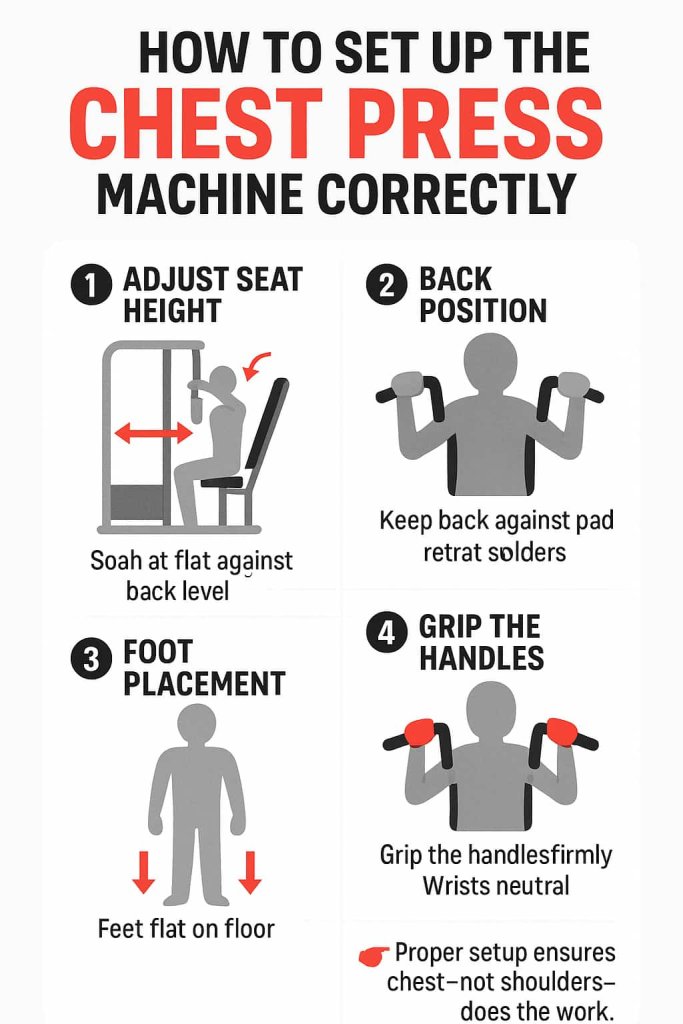
- Adjust the seat height so the handles are level with your mid-chest.
- Keep your back flat against the pad with shoulder blades retracted.
- Plant your feet firmly on the ground for stability.
- Grip the handles fully, keeping wrists straight.
Fitness experts emphasize that correct alignment on the chest press machine ensures the chest—not the shoulders—does most of the work, which both protects the joints and maximizes muscle activation.
2. Control Your Tempo and Add Pauses
Fast, jerky reps reduce time under tension. For hypertrophy, control is king.
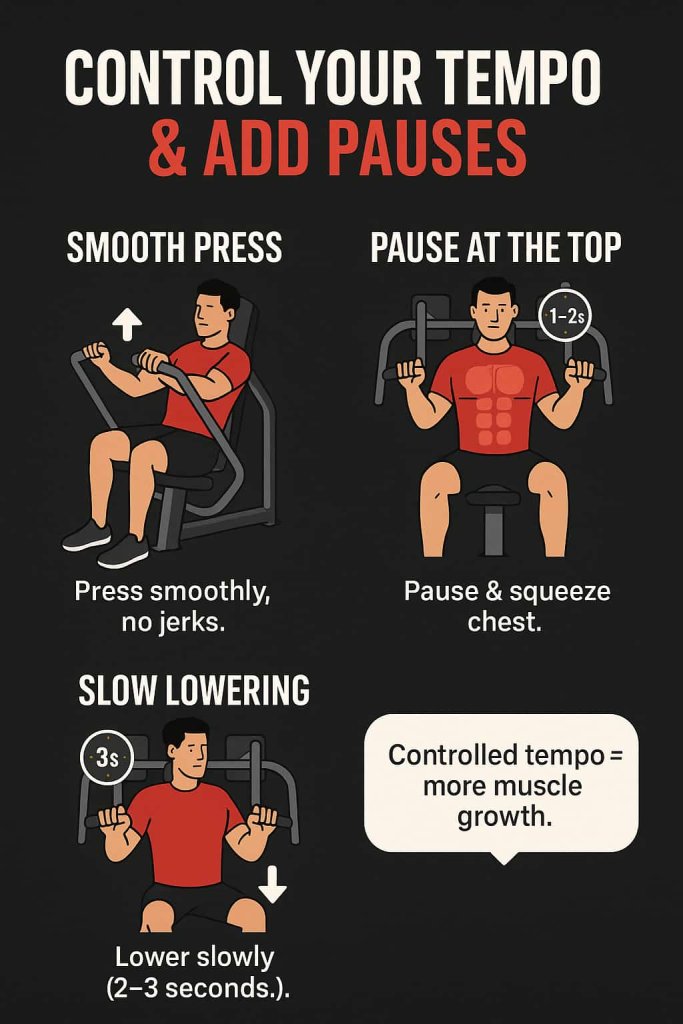
- Press the handles smoothly—avoid explosive thrusts.
- Pause at the top for 1–2 seconds to squeeze your chest.
- Lower slowly (2–3 seconds) to maximize eccentric activation.
A controlled tempo keeps muscles under stress longer, boosting growth. Men’s Health notes that slow eccentrics and pauses improve hypertrophy by increasing metabolic stress and muscle fiber recruitment (source).
3. Apply Progressive Overload & Variations
To grow your chest, you must challenge it consistently. Simply pressing the same weight won’t drive new growth.
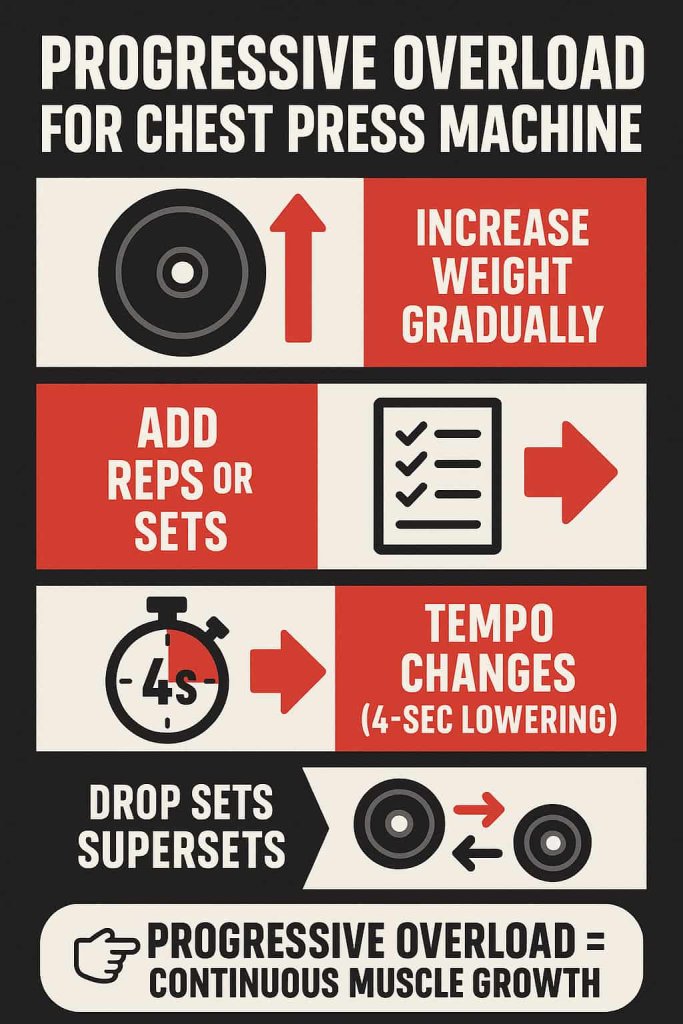
Ways to apply overload:
- Increase weight gradually.
- Add reps or sets over time.
- Use tempo changes (e.g., 4-sec lowering).
- Try drop sets or supersets for advanced hypertrophy.
👉 Progressive overload ensures continuous adaptation. Research confirms progressive resistance is the foundation of muscle growth (Journal of Strength & Conditioning Research, 2023).
4. Combine with Free Weights and Bodyweight Exercises
The chest press machine is excellent, but relying on it alone leaves gaps. Machines lock your movement path, which reduces stabilizer engagement.
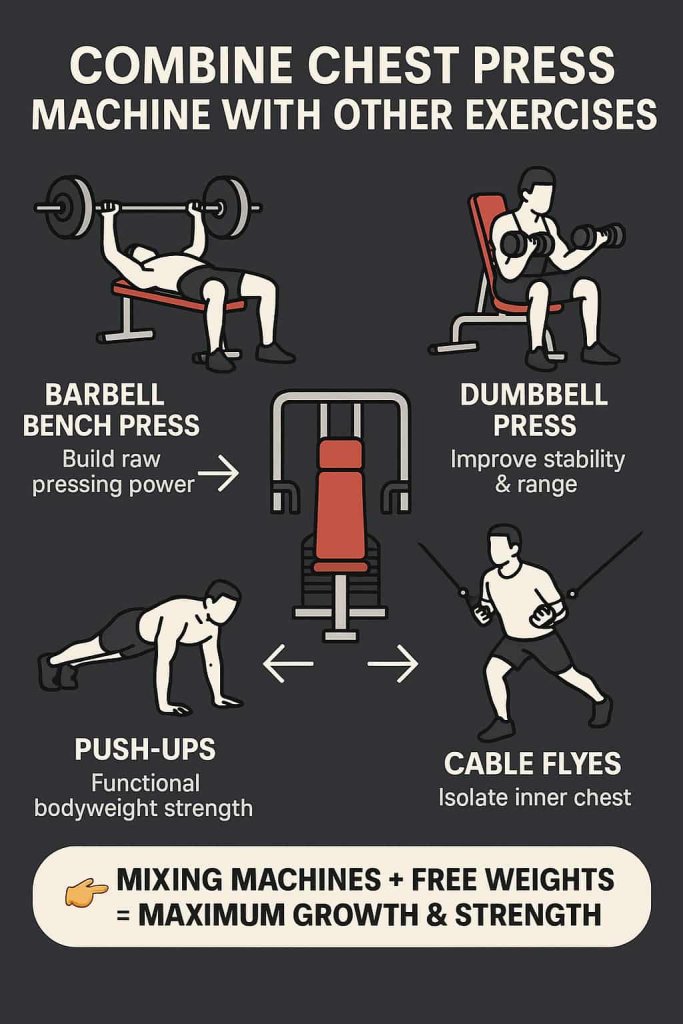
Complement with:
- Barbell Bench Press → builds raw pressing power.
- Dumbbell Press → trains stability and range of motion.
- Push-Ups → add functional, bodyweight strength.
- Cable Flyes → isolate inner chest for definition.
A GQ Fitness article highlights that mixing machines with free weights creates both functional strength and aesthetic growth.
5. Avoid Common Mistakes
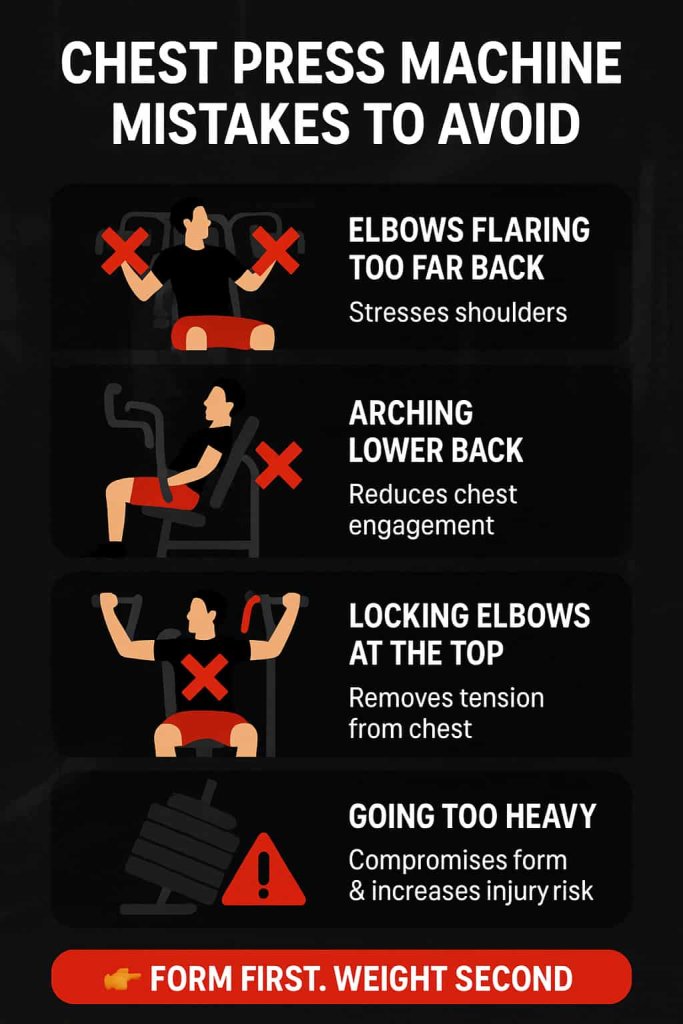
Even small mistakes can stall chest growth or cause injury. Be mindful of these pitfalls:
- ❌ Elbows flaring too far back → stresses shoulder joints.
- ❌ Arching the lower back → reduces chest engagement.
- ❌ Locking elbows at the top → shifts tension off the chest.
- ❌ Going too heavy → compromises form and increases injury risk.
Experts warn that improper form on the chest press machine can lead to shoulder strain and reduced chest activation. Always prioritize form over ego lifting.
Muscles Worked by the Chest Press Machine
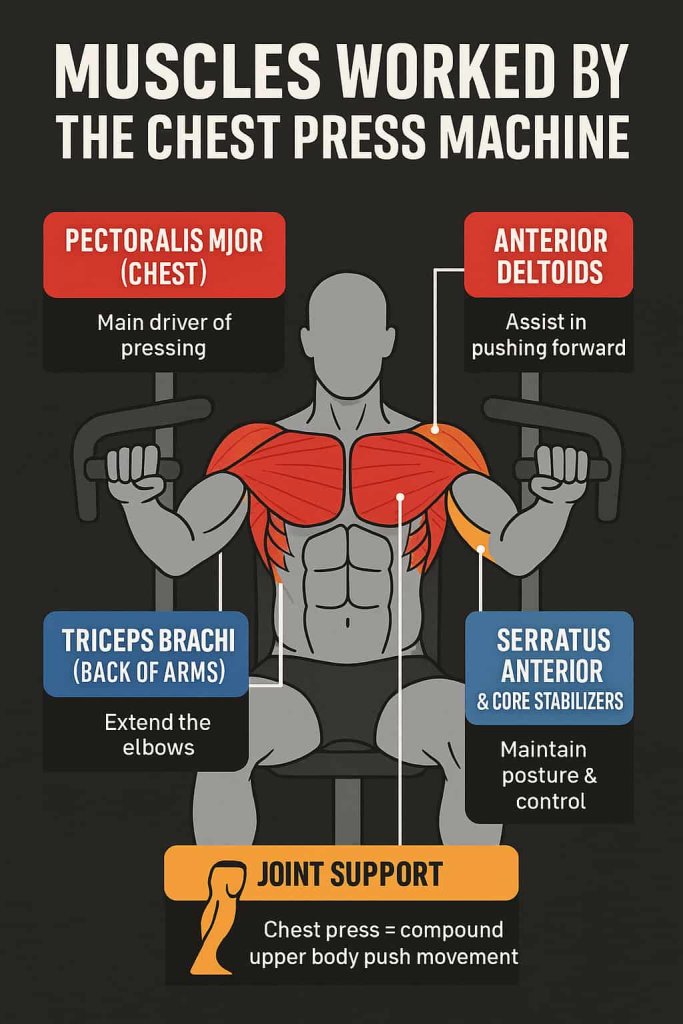
The chest press machine primarily targets the pectoralis major (the large chest muscle), but it also recruits several supporting muscles:
- Pectoralis Major (Chest) → Main driver of pressing movement.
- Anterior Deltoids (Front Shoulders) → Assist in pushing the weight forward.
- Triceps Brachii (Back of Arms) → Extend the elbows during pressing.
- Serratus Anterior & Core Stabilizers → Help maintain posture and pressing control.
👉 This makes the machine not just a “chest-only” exercise, but a compound movement that develops the upper body pressing chain.
Chest Press Machine vs. Bench Press: Which Is Better?
Both exercises are effective, but they serve slightly different purposes:
Chest Press Machine
- ✅ Safer without a spotter
- ✅ Easier for beginners to learn
- ✅ Keeps form consistent with guided path
- ❌ Less stabilizer engagement
Bench Press (Barbell or Dumbbell)
- ✅ Builds raw pressing power
- ✅ Engages stabilizers for functional strength
- ✅ Greater freedom of motion (especially dumbbells)
- ❌ Requires more technique and safety awareness
👉 Best approach: Use bench press for strength and functional gains while using the chest press machine for volume, isolation, and safer hypertrophy work. Combining both ensures well-rounded chest development.
Alternatives to the Chest Press Machine
If you don’t have access to the chest press machine, or you want to keep your training fresh, try these effective alternatives:
- Flat Barbell Bench Press → Classic compound lift for strength and mass.
- Incline Dumbbell Press → Targets the upper chest for fuller development.
- Push-Ups (Weighted or Bodyweight) → Scalable and functional.
- Chest Dips → Great for lower chest and triceps engagement.
- Cable Chest Press → Mimics machine pressing but allows more freedom of motion.
👉 These alternatives not only replicate chest press benefits but also add variety, helping you avoid plateaus.
FAQ: Chest Press Machine for Bigger Chest
1. Is the chest press machine good for beginners?
Yes. It provides stability and safety, making it ideal for learning pressing mechanics without a spotter.
2. Does the chest press machine build muscle like the bench press?
It builds muscle effectively, but the bench press recruits more stabilizers. Best results come from using both.
3. How many sets and reps should I do on the chest press machine?
For hypertrophy: 3–4 sets of 8–12 reps with controlled tempo.
4. Should I do chest press before or after free weights?
Most lifters use it after free weights as a safe finisher to exhaust the chest. Beginners may start with it first for confidence.
5. Can I replace bench press with chest press machine?
You can, but you’ll miss some stabilizer activation. Use the machine to supplement—not replace—compound lifts.
6. How much weight should I use on the chest press machine?
Choose a weight you can press with good form for 8–12 reps at RPE 7–8 (about 70–80% effort).
7. How often should I use the chest press machine?
2 times per week is sufficient when combined with other chest exercises.
Conclusion
The chest press machine is a powerful tool for chest growth—if used with proper setup, controlled tempo, progressive overload, and in combination with free weights. Avoid common mistakes and treat it as one part of a complete chest routine.
👉 Start applying these five tips today to unlock bigger, stronger chest gains—safely and effectively.
